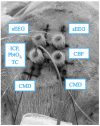A comprehensive neuromonitoring approach in a large animal model of cardiac arrest
- PMID: 35229991
- PMCID: PMC8879632
- DOI: 10.1002/ame2.12200
A comprehensive neuromonitoring approach in a large animal model of cardiac arrest
Abstract
Background: Anoxic brain injuries represent the main determinant of poor outcome after cardiac arrest (CA). Large animal models have been described to investigate new treatments during CA and post-resuscitation phase, but a detailed model that includes extensive neuromonitoring is lacking.
Method: Before an electrically-induced 10-minute CA and resuscitation, 46 adult pigs underwent neurosurgery for placement of a multifunctional probe (intracranial pressure or ICP, tissue oxygen tension or PbtO2 and cerebral temperature) and a bolt-based technique for the placement and securing of a regional blood flow probe and two sEEG electrodes; two modified cerebral microdialysis (CMD) probes were also inserted in the frontal lobes and accidental misplacement was prevented using a perforated head support.
Result: 42 animals underwent the CA procedure and 41 achieved the return of spontaneous circulation (ROSC). In 4 cases (8.6%) an adverse event took place during preparation, but only in two cases (4.3%) this was related to the neurosurgery. In 6 animals (13.3%) the minor complications that occurred resolved after probe repositioning.
Conclusion: Herein we provide a detailed comprehensive neuromonitoring approach in a large animal model of CA that might help future research.
Keywords: anoxic injury; heart arrest; ischemiareperfusion; post‐arrest; resuscitation.
© 2022 The Authors. Animal Models and Experimental Medicine published by John Wiley & Sons Australia, Ltd on behalf of The Chinese Association for Laboratory Animal Sciences.
Conflict of interest statement
The Authors have no conflict of interests to declare that compromise the quality of this article.
Figures




References
-
- Gräsner J‐T, Herlitz J, Tjelmeland IBM, et al. European resuscitation council guidelines 2021: Epidemiology of cardiac arrest in Europe. Resuscitation. 2021;161:61‐79. - PubMed
-
- Lemiale V, Dumas F, Mongardon N, et al. Intensive care unit mortality after cardiac arrest: the relative contribution of shock and brain injury in a large cohort. Intensive Care Med. 2013;39:1972‐1980. - PubMed
-
- Taccone FS, Crippa IA, Dell’Anna AM, Scolletta S. Neuroprotective strategies and neuroprognostication after cardiac arrest. Best Pract Res Clin Anaesthesiol. 2015;29:451‐464. - PubMed
-
- Lascarrou JB, Merdji H, Le Gouge A, et al. Target temperature management for cardiac arrest with no shockable rhythm. N Engl J Med. 2019;381(24):2327‐2337. - PubMed
Publication types
MeSH terms
LinkOut - more resources
Full Text Sources
Medical

